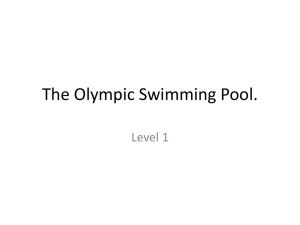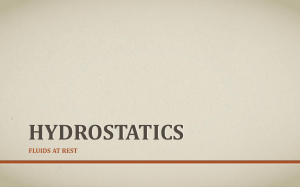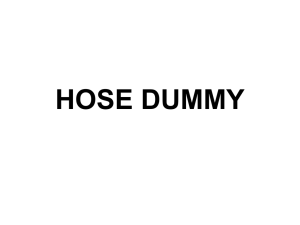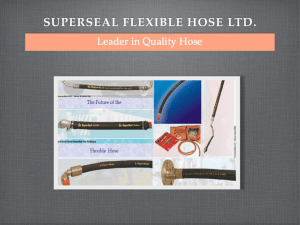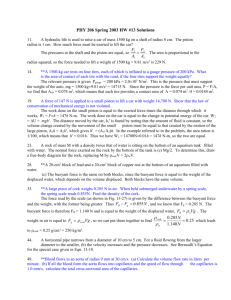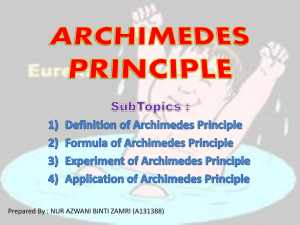Chapter 15 Solutions
advertisement
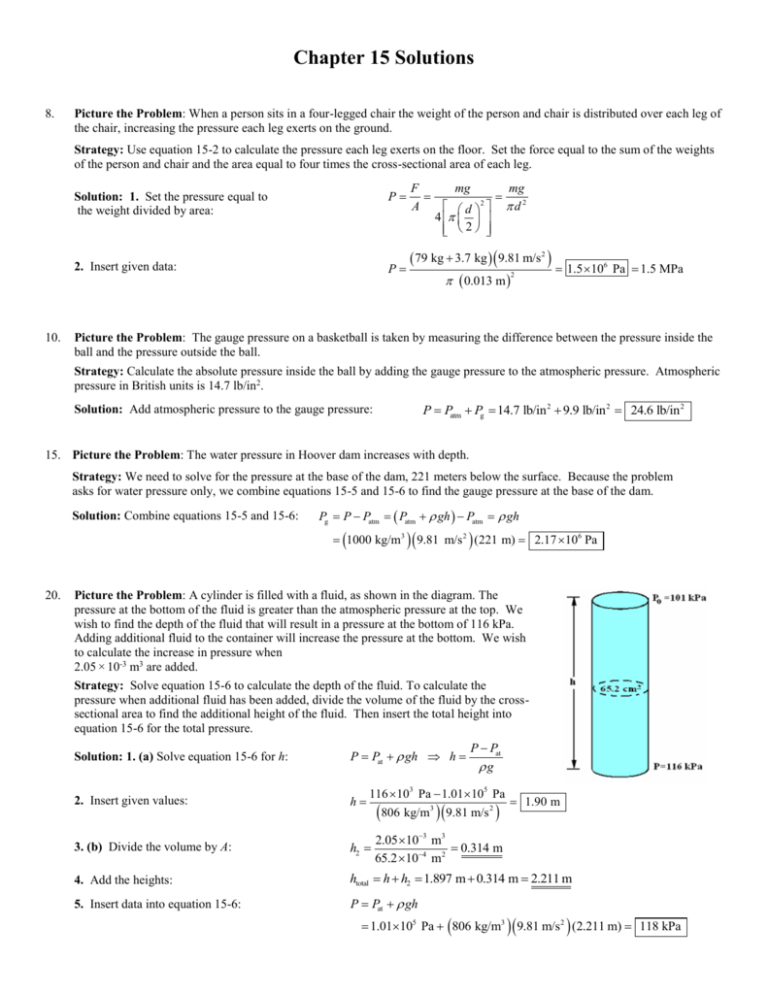
Chapter 15 Solutions 8. Picture the Problem: When a person sits in a four-legged chair the weight of the person and chair is distributed over each leg of the chair, increasing the pressure each leg exerts on the ground. Strategy: Use equation 15-2 to calculate the pressure each leg exerts on the floor. Set the force equal to the sum of the weights of the person and chair and the area equal to four times the cross-sectional area of each leg. 10. Solution: 1. Set the pressure equal to the weight divided by area: P 2. Insert given data: P F mg mg 2 A d2 d 4 2 79 kg 3.7 kg 9.81 m/s2 1.5 106 2 0.013 m Pa 1.5 MPa Picture the Problem: The gauge pressure on a basketball is taken by measuring the difference between the pressure inside the ball and the pressure outside the ball. Strategy: Calculate the absolute pressure inside the ball by adding the gauge pressure to the atmospheric pressure. Atmospheric pressure in British units is 14.7 lb/in2. P Patm Pg 14.7 lb/in 2 9.9 lb/in 2 24.6 lb/in 2 Solution: Add atmospheric pressure to the gauge pressure: 15. Picture the Problem: The water pressure in Hoover dam increases with depth. Strategy: We need to solve for the pressure at the base of the dam, 221 meters below the surface. Because the problem asks for water pressure only, we combine equations 15-5 and 15-6 to find the gauge pressure at the base of the dam. Solution: Combine equations 15-5 and 15-6: Pg P Patm Patm gh Patm gh 1000 kg/m3 9.81 m/s 2 (221 m) 2.17 106 Pa 20. Picture the Problem: A cylinder is filled with a fluid, as shown in the diagram. The pressure at the bottom of the fluid is greater than the atmospheric pressure at the top. We wish to find the depth of the fluid that will result in a pressure at the bottom of 116 kPa. Adding additional fluid to the container will increase the pressure at the bottom. We wish to calculate the increase in pressure when 2.05 × 10-3 m3 are added. Strategy: Solve equation 15-6 to calculate the depth of the fluid. To calculate the pressure when additional fluid has been added, divide the volume of the fluid by the crosssectional area to find the additional height of the fluid. Then insert the total height into equation 15-6 for the total pressure. P Pat g Solution: 1. (a) Solve equation 15-6 for h: P Pat gh h 2. Insert given values: h 3. (b) Divide the volume by A: h2 4. Add the heights: htotal h h2 1.897 m 0.314 m 2.211 m 5. Insert data into equation 15-6: P Pat gh 116 103 Pa 1.01 105 Pa 806 kg/m 9.81 m/s 3 2 1.90 m 2.05 103 m3 0.314 m 65.2 104 m2 1.01105 Pa 806 kg/m3 9.81 m/s2 (2.211 m) 118 kPa 32. Picture the Problem: The weight of a horse is supported by the additional buoyant force provided by the raft sinking 2.7 cm into the water. Strategy: Set the weight of the horse equal to the increase in the buoyant force from the additional submerged volume of the raft. Solution: Set the weight equal to the buoyant force using equation 15-9: 34. Fb W Vg 1000 kg/m3 4.2 m 6.5 m 0.027 m 9.81 m/s 2 7.2 kN Picture the Problem: A helium balloon displaces heavier air, causing it to rise. We want to calculate the maximum additional weight that the balloon can lift. Strategy: Calculate the buoyant force on the balloon using equation 15-9 with the density of air and the volume of a sphere. Subtract the weight of the balloon and the weight of the helium ( W HeVg ) to calculate the additional weight the balloon can lift. 3 4 4 Fb airVg air r 3 g 1.29 kg/m3 4.9 m 9.81 m/s 2 6236 N Solution: 1. Calculate the buoy3 3 ant force on the balloon: 2. Subtract the weight of the balloon and of the helium: 42. W Fb mballoon g HeVHe g 6236 N 3.2 kg 9.81 m/s 2 3 4 0.179 kg/m3 4.9 m 9.81 m/s 2 5.3 kN 3 Picture the Problem: An air mattress floats in fresh water. We wish to calculate the maximum mass that the air mattress will support. Strategy: Use equation 15-9 to calculate the buoyant force of the air mattress. Set the buoyant force equal to the weight of the air mattress and the maximum additional weight. Solve for the additional weight and divide by gravity to calculate the maximum mass that can be supported on the air mattress. Solution: 1. Set the buoyant force equal to the weight supported: FB Wmax Wam Wmax FB Wam Wmax H2 OVam g mam g 2. Divide by gravity to calculate the mass: Wmax H2 OVam mam g mmax 1000 kg/m3 2.3 m 0.66 m 0.14 m 0.22 kg 210 kg 51. Picture the Problem: Water flows through a hose at a constant volume flow rate. When the diameter of the hose is decreased by partially blocking the end, the speed through the end increases so the same volume flows in the same time. Strategy: We wish to find the speed through the partially blocked end. Write the continuity equation (15-12) in terms of the diameters of the hose and solve for the speed at the end. Solution: 1. Write the continuity equation in terms of the diameters of the hose: d 1 A1v1 A2 v2 2 / 4 v1 d 2 2 / 4 v2 2 2. Solve for the end velocity: 2 d 3.4 cm v2 1 v1 1.1 m/s 39 m s 0.57 cm d2 53. Picture the Problem: A child’s pool is filled from a garden hose. The volume flow rate through the hose is equal to the rate at which the pool fills. Strategy: In this problem we wish to calculate the time necessary to fill the pool. Use the volume continuity equation Apool vpool Ahose vhose (equation 15-11) to calculate the speed at which the water rises in the pool. Divide the depth of the pool by the speed of the rising water to determine the time necessary to fill the pool. vpool Solution: 1. Solve the continuity equation for the speed at which the pool fills: 1 d d2 A hose vhose 41 hose vhose hose 2 d Apool 4 d pool pool 2 vhose 2 0.029 m 4 1.3 m/s 2.7 10 m/s 2.0 m 2. Divide the height of the pool by the fill speed to find the required fill time: 60. t h vpool 0.26 m 1 min 960 s 16 min 4 2.7 10 m/s 60 sec Picture the Problem: The diagram shows water flowing through a pipe with a speed v1 = 1.4 m/s. The pipe narrows to half of its initial diameter. Strategy: We wish to find the speed and pressure in the narrow region. Solve equation 15-12 for the speed v2, given that d2 12 d1 . Then use equation 15-14 to calculate the pressure P2. 2 2 d / 4 d A v2 1 v1 1 v1 1 v1 A2 d2 / 4 d2 Solution: 1. (a) Solve the continuity equation for the speed v2: A1v1 A2 v2 2. Insert the given data: d v2 1 1 v1 4v1 4 1.6 m/s 6.4 m/s 2 d1 3. (b) Solve equation 15-14 for P2: P1 2 64. 1 1 v12 P2 v2 2 2 2 1 P2 P1 v12 v22 2 1 2 2 110 103 Pa+ 1000 kg/m3 1.6 m/s 6.4 m/s 2 P2 91 kPa Picture the Problem: Water flows out of a hole in a tank h = 2.5 m below the water level in the tank. Strategy: We want to calculate the speed of the water. Use Torricelli’s Law to calculate the speed of the water: Solution: Insert the given height into equation 15-17: v2 2 gh 2 9.81 m/s 2 2.7 m v2 7.3 m/s
